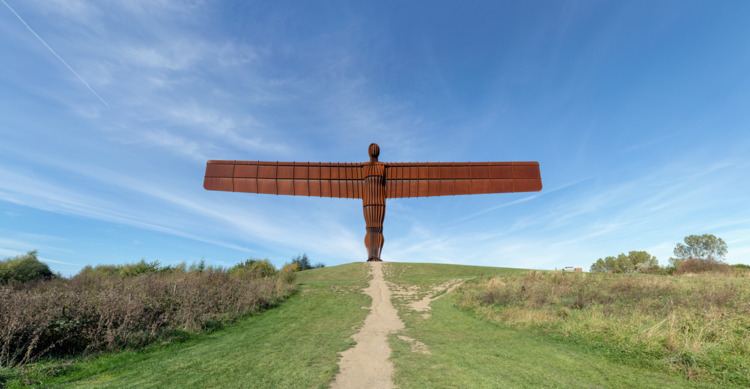Created 16 February 1998 | Dimensions 20 m x 54 m | |
 | ||
Similar Quantum Cloud, Gateshead Millennium Bridge, Another Place, Baltic Centre for Contemp, Tyne Bridge | ||
Aerial views of the angel of the north taken from a quadcopter
The Angel of the North is a contemporary sculpture, designed by Antony Gormley, located in Gateshead in Tyne and Wear, England.
Contents
- Aerial views of the angel of the north taken from a quadcopter
- Angel of the north
- Concept
- Construction
- Maquettes
- Other projects
- References
Completed in 1998, it is a steel sculpture of an angel, 20 metres (66 ft) tall, with wings measuring 54 metres (177 ft) across. The wings do not stand straight sideways, but are angled 3.5 degrees forward; Gormley did this to create "a sense of embrace".
It stands on a hill just to the north of Birtley, overlooking the A1 and A167 roads into Tyneside, and the East Coast Main Line rail route, south of the site of Team Colliery.
Angel of the north
Concept
According to Gormley, the significance of an angel was three-fold: first, to signify that beneath the site of its construction, coal miners worked for two centuries; second, to grasp the transition from an industrial to an information age, and third, to serve as a focus for our evolving hopes and fears.
Construction
Work began on the project in 1994 and cost £800,000. Most of the project funding was provided by the National Lottery. The Angel was finished on 16 February 1998.
Due to its exposed location, the sculpture was built to withstand winds of over 100 mph (160 km/h). Thus, foundations containing 600 tonnes (590 long tons; 660 short tons) of concrete anchor the sculpture to rock 70 feet (21 m) below. The sculpture was built at Hartlepool Steel Fabrications Ltd using COR-TEN weather-resistant steel. It was made in three parts—with the body weighing 100 tonnes (98 long tons; 110 short tons) and two wings weighing 50 tonnes (49 long tons; 55 short tons) each — then brought to its site by road. It took five hours for the body to be transported from its construction site in Hartlepool, up the A19 road to the site.
The Angel aroused some controversy in British newspapers, at first, including a "Gateshead stop the statue" campaign, while local councillor Martin Callanan was especially strong in his opposition. However, it has since been considered to be a landmark for North East England and has been listed by one organisation as an "Icon of England". It has often been used in film and television to represent Tyneside, as are other local landmarks such as the Tyne Bridge and the Gateshead Millennium Bridge.
The sculpture is also known by some local people as the "Gateshead Flasher", because of its location and appearance.
Maquettes
Several maquettes were produced during the development stage of the project. A life-size model from which the sculpture was created was sold at auction for £2.28 million in July 2008. An additional bronze maquette used in fundraising in the 1990s, owned by Gateshead Council, was valued at £1 million on the BBC show Antiques Roadshow on 16 November 2008—the most valuable item ever appraised on the programme. In 2011 German fashion designer Wolfgang Joop sold his life-size maquette (previously kept in the garden of his mansion in Potsdam, Germany) at an auction at Christie's in London for £3.4m to an anonymous bidder. Another maquette was donated to the National Gallery of Australia in 2009 and stands in its Sculpture Garden.
Other projects
Inspired by the Angel of the North, several similar projects have been proposed. The Angel of the South title has been given by some to the Willow Man, which sits to the side of the M5 in Somerset, while a project, informally named the Angel of the South, has been proposed in Ebbsfleet, Kent. The sculpture Brick Man (also by Gormley) was proposed for the Holbeck area of Leeds.
